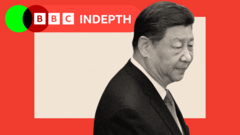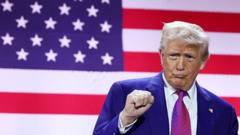With dwindling consumer confidence and a struggling economy, Xi's strategies will be tested against external pressures.
**Xi Jinping's Leadership Under Fire: Navigating Economic Turmoil Amidst Trump's Trade Tactics**

**Xi Jinping's Leadership Under Fire: Navigating Economic Turmoil Amidst Trump's Trade Tactics**
China's market faces a pivotal moment as President Xi contemplates domestic challenges amidst U.S. tariffs.
In the bustling wholesale markets and trade fairs across China, the mention of Donald Trump stirs a mix of chuckles and disdain rather than fear. Rather than succumbing to the anxiety fueled by his hefty tariffs, many Chinese traders have turned the tide by mocking Trump in viral memes and videos, some featuring AI-generated portrayals of the U.S. president and his associates laboring on production lines. President Xi Jinping has reaffirmed that Beijing will not concede to external pressures, standing firm on China's traditional approach of self-reliance and perseverance.
"For over seven decades, China has thrived on its own hard work and self-dependence," Xi proclaimed this month, dispelling the notion that his nation could be intimidated by aggressive U.S. trade policies. His confidence springs from the observed shift in China's economic structure; the nation now relies less on U.S. exports than it did a decade ago. However, Trump's escalating tariffs are squeezing an already struggling Chinese economy, marked by a housing crisis, job insecurity, and an aging population leading to decreased consumer spending.
Upon ascending to power in 2012, Xi's vision was a revitalized China, now facing formidable domestic challenges and pressure from U.S. trade policies. The burning question remains whether these sanctions will thwart Xi’s aspirations or if he can pivot the current hurdles into viable prospects. China boasts a vast domestic market of 1.4 billion, yet uncertainty looms as consumers hesitate to spend, overwhelmed by a faltering housing market that has siphoned family savings and confidence.
Government actions to limit developer borrowing came too late to halt the plummeting prices, leaving swathes of unused apartments across the nation—what many refer to as "ghost cities." Skyscrapers stand partially furnished, their potential homes abandoned as buyers remain elusive. The former deputy head of China's statistics bureau alarmingly estimated a surplus of homes that could accommodate three billion people, signifying an oversupply of housing that the government could not remedy.
Furthermore, anxieties linger over the long-term viability of government pension systems as millions of older workers near retirement. Projections indicate the pension fund could become insolvent by 2035. The growing cohort of unemployed young graduates further clouds the economic landscape, with youth unemployment climbing to alarming numbers, reportedly exceeding 20% in urban sectors.
Transitioning from global exports to domestic consumption will demand time and strategic policy adjustments as experts predict continued economic strain. Research suggests that without ample domestic demand, China may struggle to mitigate the impacts of further U.S. tariffs effectively. Analysts indicate that the true battleground for China lies within its domestic economic policies rather than international negotiations with the Trump administration.
Measures such as a multi-billion-dollar subsidy program aimed at bolstering childcare expenses and wage increases have been introduced to stimulate spending. Some experts, however, warn these short-term fixes may not be sustainable in the long-run without enhancing personal disposable incomes.
Xi's acknowledgment of a disillusioned younger generation sparks concern for the Communist Party's stability. Reports indicate increased protest activity fueled by economic frustrations, albeit typically suppressed by state controls. Xi's past assurances of collective prosperity are under scrutiny as financial uncertainties mount.
While China has fostered advancement in consumer technology and electric vehicles, the looming specter of U.S. tariffs threatens to undermine these achievements. Control over semiconductor technology is seen as critical to maintaining competitive edges in emerging sectors, raising concerns for Xi’s strategic ambitions.
However, Xi is determined to leverage this economic pressure as a springboard for greater innovation and the diversification of international markets. He aims to redirect exports to new regions, with a significant portion of trade now routed through Southeast Asia, Africa, and Latin America. As China adapts, it seeks to bolster its global trade partnerships, evidenced by growing trade ties with over 145 nations that prioritize China over the U.S. in commerce.
The geopolitical landscape remains susceptible to shifts, and while navigating the complexities of trade policies, caution is urged as histories of dumping previously enflamed regional tensions. China's previous use of tariffs has marred international relations, creating hesitancies among nations solicited to choose between collaborating with Beijing or Washington.
Ultimately, through all turbulence, Xi remains confident that Beijing can withstand economic setbacks longer than the U.S. can. Despite the uncertainties, signs of a softer tone from Trump regarding tariffs emerge as potential negotiations between the powers lie ahead. Chinese social media pulses with opinions reflecting national pride and resilience, underscoring a narrative of anticipating a longer game where Beijing must address internal challenges outside the realm of external pressures.
"For over seven decades, China has thrived on its own hard work and self-dependence," Xi proclaimed this month, dispelling the notion that his nation could be intimidated by aggressive U.S. trade policies. His confidence springs from the observed shift in China's economic structure; the nation now relies less on U.S. exports than it did a decade ago. However, Trump's escalating tariffs are squeezing an already struggling Chinese economy, marked by a housing crisis, job insecurity, and an aging population leading to decreased consumer spending.
Upon ascending to power in 2012, Xi's vision was a revitalized China, now facing formidable domestic challenges and pressure from U.S. trade policies. The burning question remains whether these sanctions will thwart Xi’s aspirations or if he can pivot the current hurdles into viable prospects. China boasts a vast domestic market of 1.4 billion, yet uncertainty looms as consumers hesitate to spend, overwhelmed by a faltering housing market that has siphoned family savings and confidence.
Government actions to limit developer borrowing came too late to halt the plummeting prices, leaving swathes of unused apartments across the nation—what many refer to as "ghost cities." Skyscrapers stand partially furnished, their potential homes abandoned as buyers remain elusive. The former deputy head of China's statistics bureau alarmingly estimated a surplus of homes that could accommodate three billion people, signifying an oversupply of housing that the government could not remedy.
Furthermore, anxieties linger over the long-term viability of government pension systems as millions of older workers near retirement. Projections indicate the pension fund could become insolvent by 2035. The growing cohort of unemployed young graduates further clouds the economic landscape, with youth unemployment climbing to alarming numbers, reportedly exceeding 20% in urban sectors.
Transitioning from global exports to domestic consumption will demand time and strategic policy adjustments as experts predict continued economic strain. Research suggests that without ample domestic demand, China may struggle to mitigate the impacts of further U.S. tariffs effectively. Analysts indicate that the true battleground for China lies within its domestic economic policies rather than international negotiations with the Trump administration.
Measures such as a multi-billion-dollar subsidy program aimed at bolstering childcare expenses and wage increases have been introduced to stimulate spending. Some experts, however, warn these short-term fixes may not be sustainable in the long-run without enhancing personal disposable incomes.
Xi's acknowledgment of a disillusioned younger generation sparks concern for the Communist Party's stability. Reports indicate increased protest activity fueled by economic frustrations, albeit typically suppressed by state controls. Xi's past assurances of collective prosperity are under scrutiny as financial uncertainties mount.
While China has fostered advancement in consumer technology and electric vehicles, the looming specter of U.S. tariffs threatens to undermine these achievements. Control over semiconductor technology is seen as critical to maintaining competitive edges in emerging sectors, raising concerns for Xi’s strategic ambitions.
However, Xi is determined to leverage this economic pressure as a springboard for greater innovation and the diversification of international markets. He aims to redirect exports to new regions, with a significant portion of trade now routed through Southeast Asia, Africa, and Latin America. As China adapts, it seeks to bolster its global trade partnerships, evidenced by growing trade ties with over 145 nations that prioritize China over the U.S. in commerce.
The geopolitical landscape remains susceptible to shifts, and while navigating the complexities of trade policies, caution is urged as histories of dumping previously enflamed regional tensions. China's previous use of tariffs has marred international relations, creating hesitancies among nations solicited to choose between collaborating with Beijing or Washington.
Ultimately, through all turbulence, Xi remains confident that Beijing can withstand economic setbacks longer than the U.S. can. Despite the uncertainties, signs of a softer tone from Trump regarding tariffs emerge as potential negotiations between the powers lie ahead. Chinese social media pulses with opinions reflecting national pride and resilience, underscoring a narrative of anticipating a longer game where Beijing must address internal challenges outside the realm of external pressures.




















